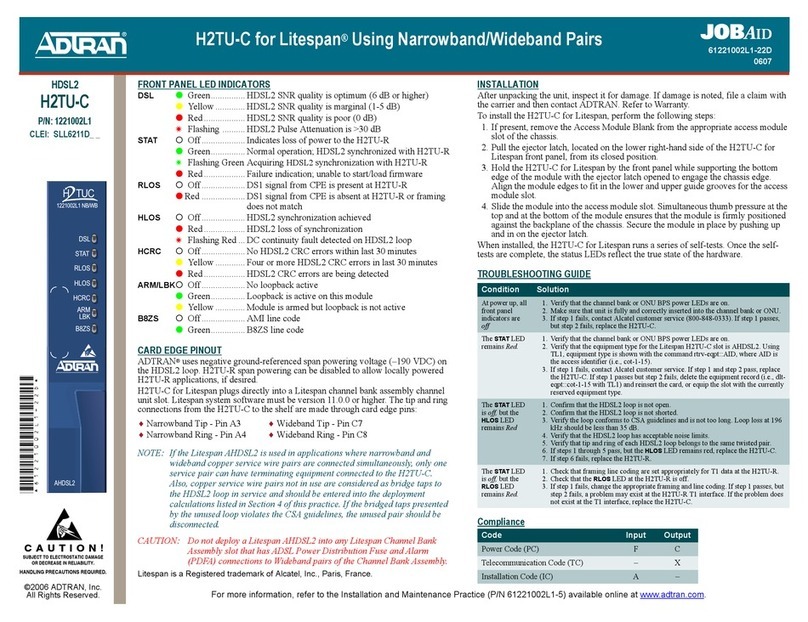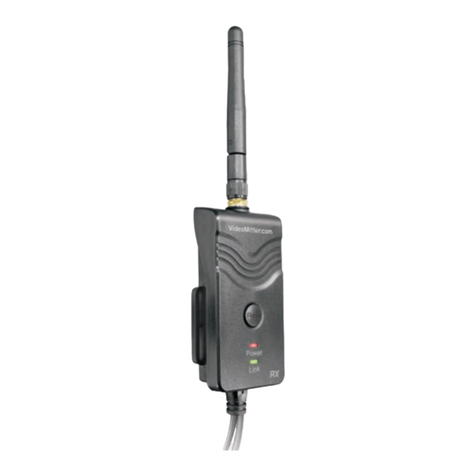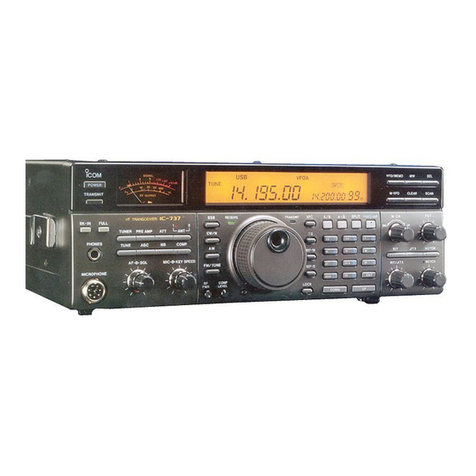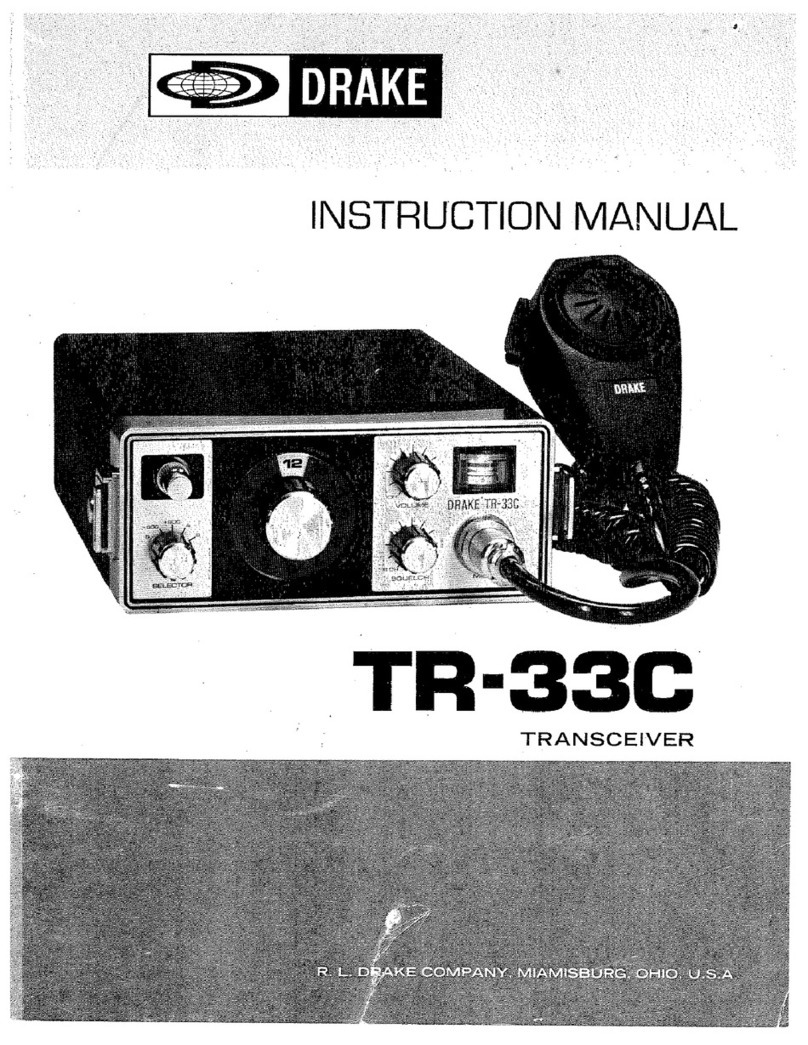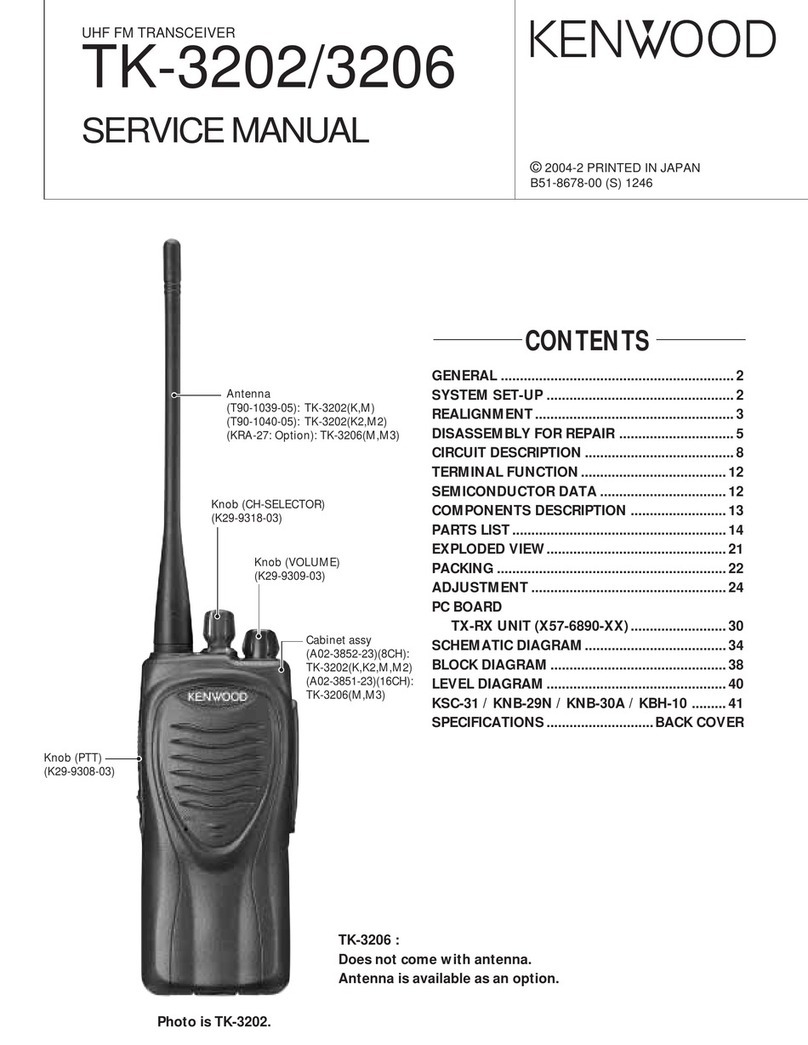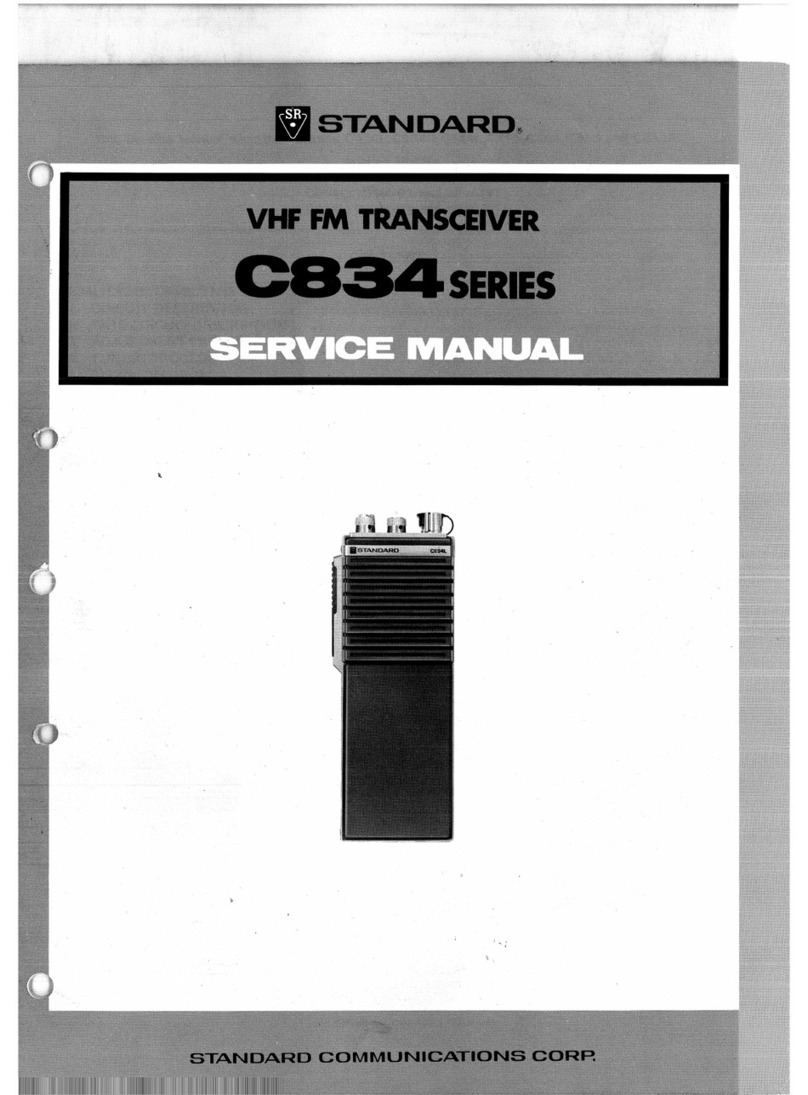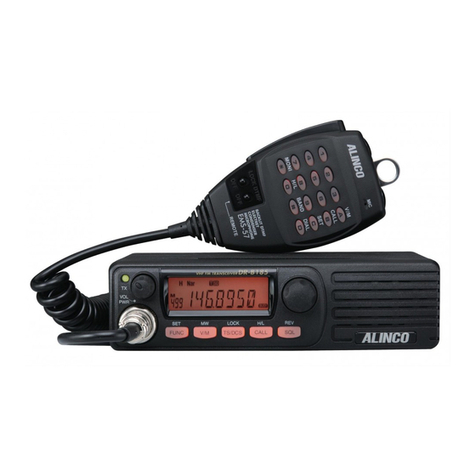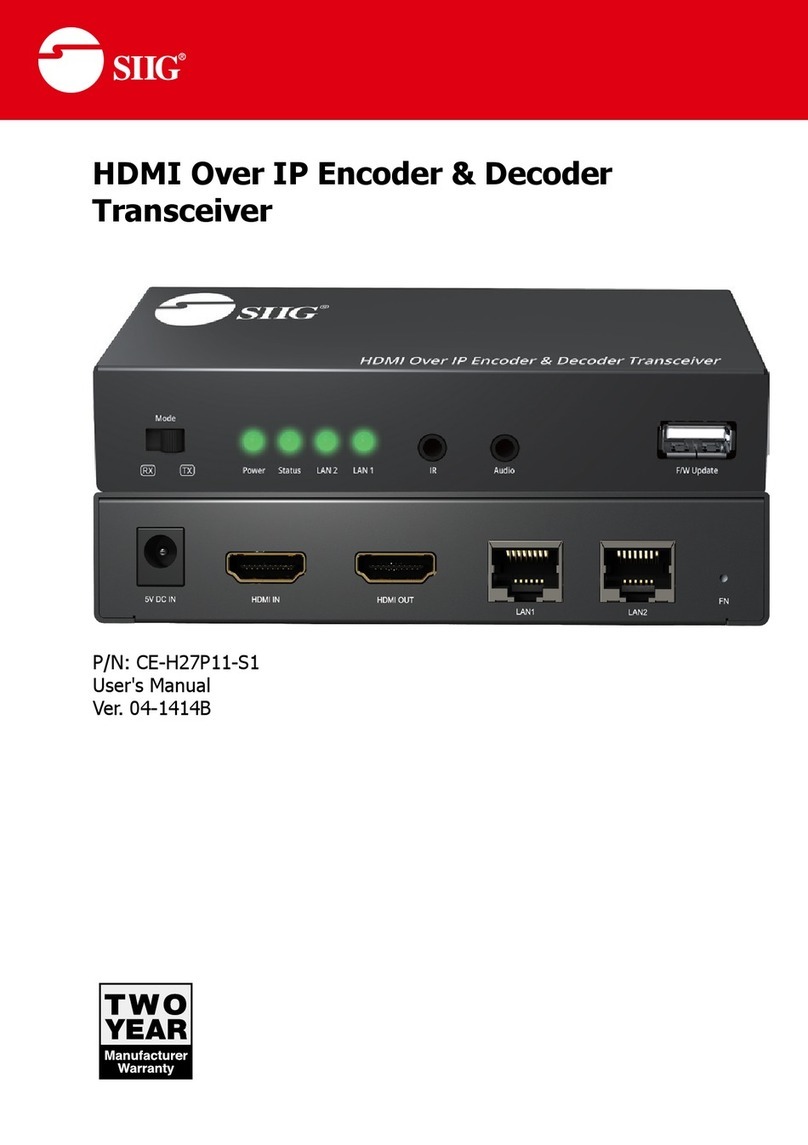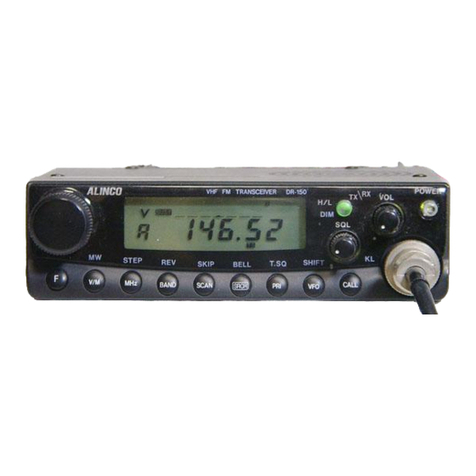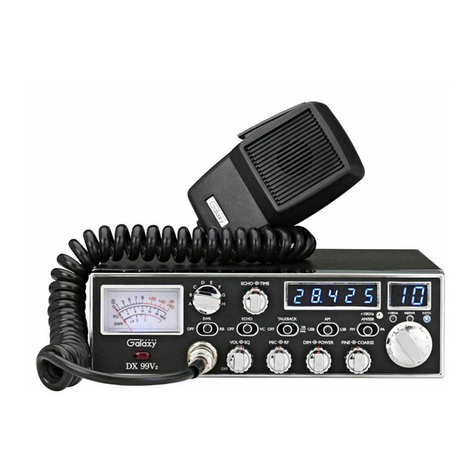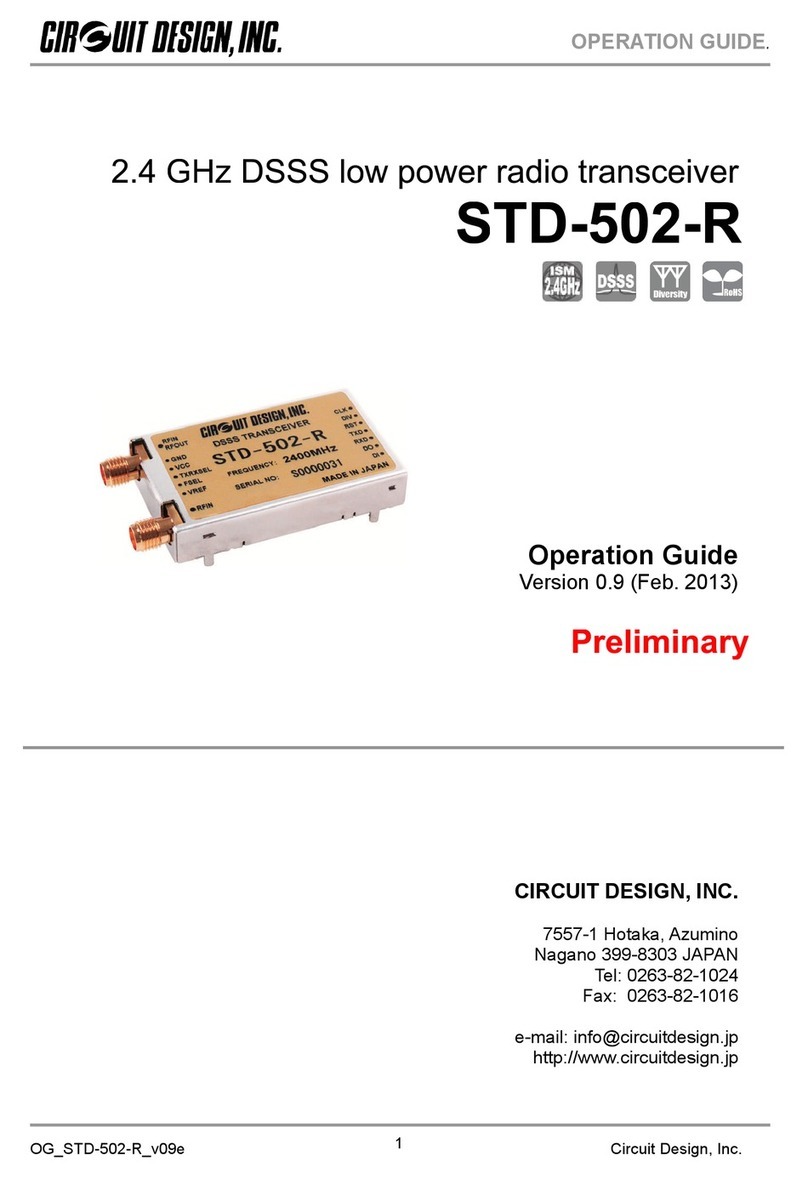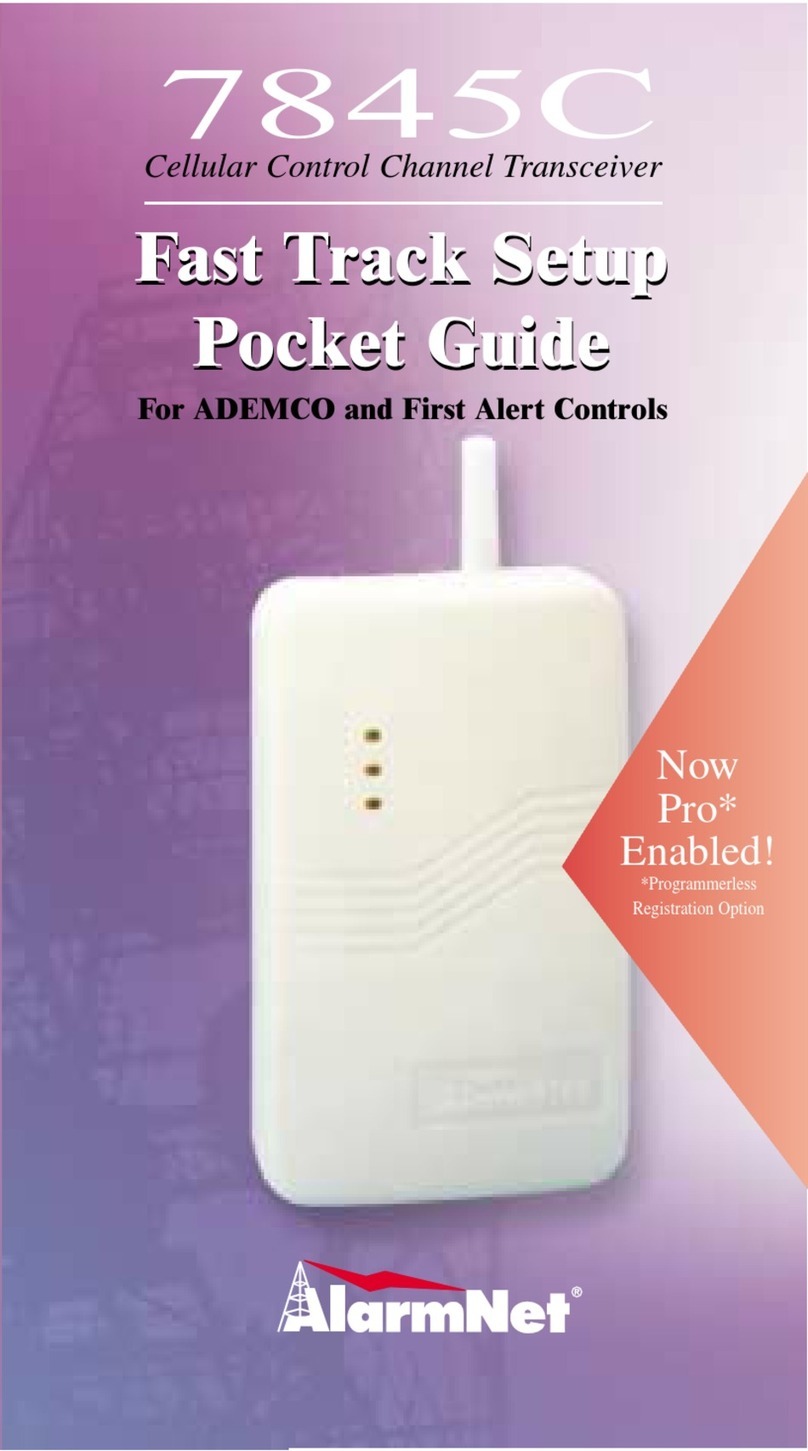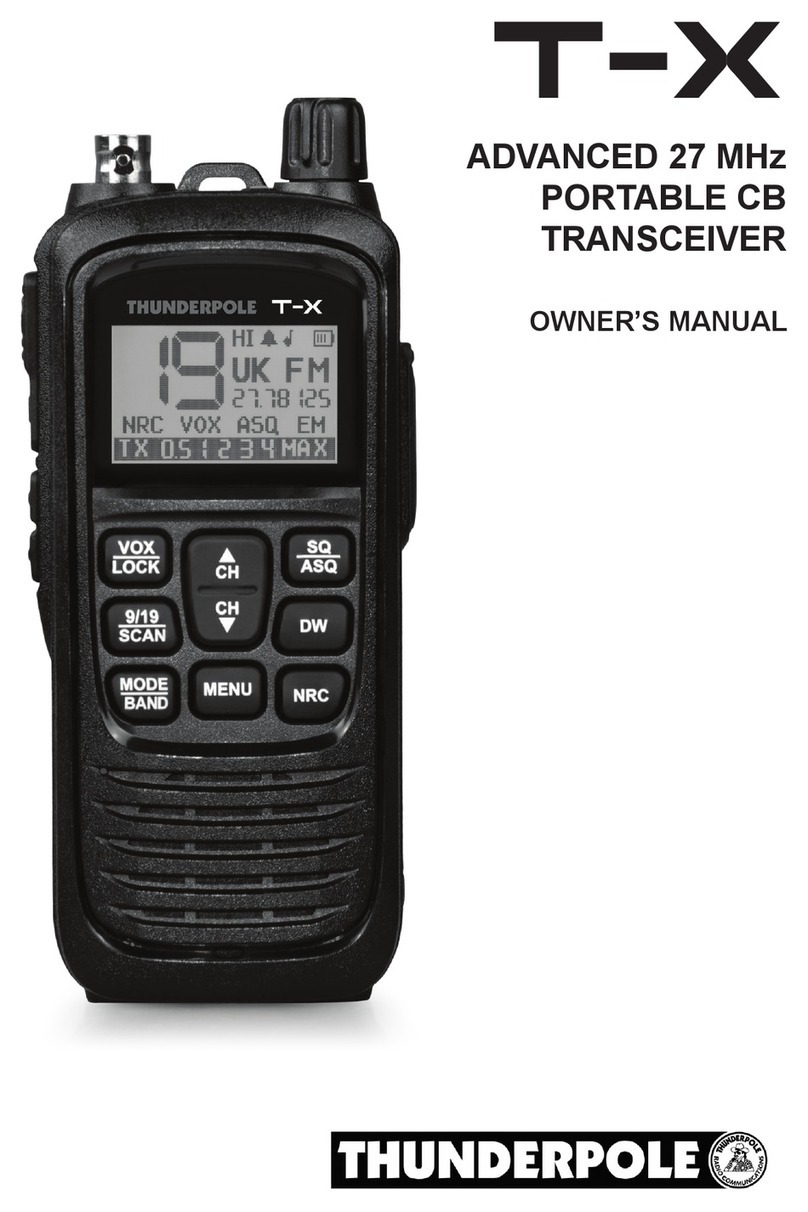Small Wonder Labs Retro-40 User manual

‘Retro-40’ Instructions July 11, 2011 Page 1
‘Retro-40’ AM Transceiver
Board Kit Instructions
For illustrative purposes only- do not use as a reference.
Thanks for purchasing a Small Wonder Labs "Retro-40" transceiver kit!
Please take a few moments to look over the sections entitled "First Things First" before
you dive in. This section contains information which is key to your success with this kit.
TABLE OF CONTENTS:
Tools/Basic Info 2,3
Component Identification 4
Retro -40 Description 5,6
Parts List 7, 8
Schematics 9-10
Pictorial Drawing 11
Building instructions 12
Wiring Up the ‘Retro-40’ 14
Alignment 15-16
Troubleshooting the "Retro-40 " [under construction]

‘Retro-40’ Instructions July 11, 2011 Page 2
THE FINE PRINT:
There are lots of small parts in this kit. I strongly
recommend a magnifying glass or close-up
glasses to check all solder joints and component
codes.
THE OTHER FINE PRINT:
If you encounter conflicts between various
sections of this document, contact me for a
resolution. The following order of precedence
applies:
•
Schematic (most trustworthy)
•
Parts list
•
Pictorial
TOOLS:
You'll need the following tools:
-Soldering iron- ~25W
- 60/40 solder, small diameter
-Diagonal cutters
-Needle-nose pliers
-Small slot screwdriver
TEST EQUIPMENT:
- Multimeter
- 50-ohm dummy load
RETRO-40 Power Requirements
.
The RETRO-40 is designed to operate with a
minimum supply voltage of approximately 10V. A
power supply capable of delivering a minimum of
1 Amp at 12-14 Volts DC is recommended.
Maximum recommended supply voltage is
16VDC.
A low-cost supply suggestion: Jameco's #319920,
15V regulated 'wall-wart'. They're at
www.jameco.com. Note: the less expensive
unregulated 'wall-warts' will not provide
adequately filtered DC- don't waste your
money! 'Filtered' is not sufficient- you need to
see the word ‘Regulated' on the description.
FIRST THINGS FIRST -
-Stuff worth knowing!
COLOR CODES:
Resistor color codes are given in the parts list.
Radio Shack's Color-Code Guide, #271-1210, or
the ARRL Handbook will help. If you're not sure,
verify the resistor values with a multimeter before
installing.
For what it's worth, roughly 8% of the male
population is red/green color-blind. If you're one of
these, you should be verifying all resistors with a
multimeter before installing them.
The RETRO-40 board is double-sided and all
holes on the board are plated-through. This
means that you do not need to solder on the top
side of the board.
SOLDERING SKILLS
Hopefully this isn't your first experience with a
soldering iron. If it is, though, or this is your first
solid-state project, here are some tips to ensure
your success:
- Soldering Iron:
Use a small iron in the 25-watt class (such as a
Radio Shack #64-2070) and keep the tip clean.
Use a moistened sponge or paper towel to clean
the tip periodically as you work.
Apply only as much heat as is needed to get a
good joint. A small vise to hold the printed-circuit
board may make soldering easier.
Touch the soldering iron tip to the PC board
trace and the component lead simultaneously.
Within a second or two, apply solder and you'll
see the solder flow onto the junction. Withdraw
the solder and then the soldering iron.
Avoid the temptation to load solder onto the joint
until no more will fit! This is an invitation for
trouble, as solder bridges may form across the
closer trace separations. Here's what the correct
and incorrect joint treatments look like:

‘Retro-40’ Instructions July 11, 2011 Page 3
.
PLEASE READ THE SECTION BELOW
BEFORE REMOVING ANY PARTS FROM THE
BOARD
Uh-oh! Sooner or later, you may need to remove
a part installed in the wrong location, or perhaps
pull a component for troubleshooting purposes.
Get yourself a roll of desoldering braid (Radio
Shack #64-2090B). Lay the end of the braid
down on the joint to be cleaned and press the
soldering iron tip over the braid. Within several
seconds you'll see the braid begin to wick up
solder from the joint. Remove the braid and
reapply a new section as needed until the joint is
clean. It may be necessary to pull the component
out from the top side of the board while heating
the joint. Leave the iron tip on the board only as
long as necessary to do the job- the PC-board
traces will eventually delaminate (peel off) if
overheated.
If that still doesn't do the job, it may be necessary
to cut the offending part off on the top side and
pull the remaining leads through with pliers.
If you need to remove a transistor, I'd highly
recommend sacrificing the part by snipping it off
on the top side of the board. The leads are best
pulled out singly to minimize the risk of lifting
pads. Contact me for replacement parts if
necessary.
After removing a component from the board, the
through-hole will probably still be blocked with
solder. Use a dissecting needle or dental probe
(explorer), apply heat to the probe and the board
trace simultaneously until the tool pushes through.
Lacking either of these tools, a round wooden
toothpick works well also!
WINDING TOROIDS:
-Count as you go. Draw each turn snug against
the core to ensure a trim and tight winding
-Double-check the turns count when you're
finished. Use your fingernail or small screwdriver
to "bump" over each turn as you count- this is
easier than counting by eye.
- Trim the excess wire off to about 3/8" (1cm) and
strip the insulation off the ends with a knife-edge
Counting the turns:
If the wire passes through the toroid center
hole, it counts as a turn. Here's an example:
MATERIALS-
You'll find the following items with your Retro-40
kit:
1- bag of parts, miscellaneous
1- antistatic bag (contains semiconductors)
1- poly bag (resistors/capacitors)
1- printed circuit board
- (these instructions )
GOOD
SOLDER FILLET IS CONCAVE AND 'WETS'
SMOOTHLY TO COMPONENT LEAD
BAD
SOLDER FILLET IS CONVEX OR DOES NOT
ADHERE TO COMPONENT LEAD
This toroid is wound with 8 turns
Turns must be uniformly distributed around
the circumference of the toroid.

‘Retro-40’ Instructions July 11, 2011 Page 4
REFERENCE DESIGNATORS:
Each component is uniquely identified with a
reference designator. Bypass capacitors are
identified as C101 and up. Reference
designators are shown in blue on the schematic
pages. Component values are shown in magenta.
C
OMPONENT IDENTIFICATION
:
•
Resistors and RF chokes
This manual describes the color coding for all
resistors. Only the first three bands are described,
the fourth band is a tolerance code, typically gold
(=5%) and is not listed. All resistors are 1/4W 5%
carbon film types, RF chokes are also an axial
(leads on each end) component but are shaped
differently.
•
Capacitors:
Electrolytic caps. The black band
denotes the negative end of the capacitor.
•
NPO Disk Caps
NPO disk caps may be distinguished from
other types of disk caps- they have a black
band at the tip of the ceramic disk.
•
Extra information on components
There's often extraneous information marked on
components. Examining a sample IC, I find
"MC1458P1 KKJK 8949". You care only about
the '1458' or other markings I've specified If I've
specified a capacitor '104' and you find the
correct number of parts, but marked "104M', for
instance, those are them!
Here's the general rule for capacitor
nomenclature:
If 3 digits are printed on the capacitor, the first two
are significant figures and the third is a multiplier.
Examples:
'471' = 47 x 10
1 =
470 pF
'103' = 10 x 10
3 =
10,000 pF = .01 uF
Letter suffixes: J=5%, K=10%, M=20%.
Please: If you're looking for a '104' monolithic
cap, be sure to inspect both sides of the caps
before concluding we gave you the wrong value!
Monolithic caps.
Poly Cap
D5- MV1662 Diode

‘Retro-40 Instructions July 11, 2011 Page 5
‘Retro-40 ‘ Description
Note: The text which follows describes the original (75M) Retro version. For the 40M
version , the IF is changed from 6 MHz to 4.915 MHz, and tuned circuits and the output
low-pass filter values are changed. The operating frequency is in the 7.0-7.3 MHz range.
Inspirations:
I’ve long been intrigued by relatively simple voice radios. The BC-611/SCR-536 [at right] was widely used
during WW II as a platoon-level radio. It had a ‘bare-bones’ crystal-controlled superhet receiver and an
AM transmitter with 350 milliwatts of output power. It had an effective range of about a mile with its built-
in whip antenna. Although pressed into service in the postwar years by enterprising hams, its lack of
selectivity limited its usefulness under crowded band conditions. As I extrapolated from this radio’s
highly inefficient whip antenna to a full-sized dipole, I realized that the effective range would be upwards
of 50 miles. In my book, that’s a usable communications distance for keeping in touch with friends! That
served as a challenge and as the inspiration for this project.
Although AM has long been supplanted by more effective modes of communication, AM activity is largely
channelized into ‘watering hole’ frequencies
.
See www.AMwindow.org . It’s therefore pretty easy to find
activity on the air. 7290 kHz is the standard ‘hot spot’ for 40M; this may vary by Region.
Receiver:
The receiver front end is entirely conventional. A series L-C T-R switch and bandpass transformer feed the SA612 first
mixer. The SA612’s internal oscillator is used to save component count by eliminating the need for a separate local
oscillator (LO) transistor. The varicap diode-tuned LO covers about 50 kHz of the 75M band. It operates at approximately
2.1 MHz and the 1
st
mixer up-converts to the Intermediate Frequency (IF).
In the interest of tradition, I initially used 455 kHz IF transformer in an IF design. A double-tuned filter using these
transformers proved woefully inadequate in keeping close-by SSB stations out of the detector stage. In light of the BC-
611’s lack of selectivity, this was largely a case of ‘reinventing the wheel’. Rather than wrestle with more stages of
filtering or the use of ceramic filters, I reverted to a tried-and-true crystal filter. I chose an IF of 6.00 MHz to keep both the
filter bandwidth and the LO frequencies reasonable. With the filter values shown on the schematic, pass bandwidth is 3.5
kHz with adequate skirt characteristics. I found it necessary to ground the case of crystal Y3 to eliminate pickup of strong
AM signals from the 49M shortwave broadcast band.
The IF amplifier uses the so-called ‘cascode’ configuration. Although the MC1350 IC is often used here, it’s been around
for an uncomfortably-long number of years. Parts cost was a factor, too- the discrete cascade amp has a parts cost of
about 15 cents. This amplifier is terminated by R6, whose value was chosen as a compromise between stage gain and
consistently stable operation.
The following stage is a peak detector which serves to recover the modulation envelope from the received signal. Q3 is
an ‘infinite-impedance detector’- a JFET biased near cutoff. I’d always wanted to say I’d used one- the phrase has a
nice ‘Hitchhiker’s Guide’ ring to it. I found it more sensitive in practice than an unbiased 1N34 Germanium diode.
U3- an LM386, is a widely-used AF Amp IC, and provides plenty of speaker volume. The transistors around it serve
several functions, Receiver audio needs to be firmly shut off during transmit. The transistor switch in series with the
LM386 output is important. That IC’s output voltage is dependent on supply voltage. As the power supply ‘pulls’ on voice
peaks, it yields an unwanted feedback path to the speaker.
The audio output waveform is also peak-detected by D6 and C20 and applied back to the gate of Q4 as a form of
Automatic Gain Control (AGC). Without it, nearby ‘Big Gun’ stations are easily capable of saturating this amplifier stage,
yielding harsh-sounding clipped audio. The AGC threshold is nominally 6 volts peak-peak, depending on the individual
characteristics of Q4. With this feedback path in place, even the strongest of stations sounds fairly clean in the receiver.
courtesy of N6GCE
www.prc68.com

‘Retro-40 Instructions July 11, 2011 Page 6
Transmitter:
The RF strip consists of a crystal-controlled Colpitts oscillator, a FET-driver IC, and a MOSFET Power Amplifier stage.
The PA stage runs class-C to keep the transmitter efficiency reasonably high. Generating an amplitude-modulated output
is done using one of the oldest tricks in the book: the transmitter’s supply voltage is varied by superimposing audio on it
through transformer T3. This is an inexpensive 48Ω:3.2Ωaudio output transformer. In this application, the transformer is
run ‘in reverse’ to step up the voltage output from U6. With no audio applied, the transmitter outputs a steady carrier. At
full (100%) modulation, the PA supply voltage swings to a minimum of 0V and to a maximum of twice the nominal supply
voltage.
In theory, this method is simplicity itself. When it’s extended to higher power levels, though, a pitfall becomes evident.
The necessary modulation transformers become rather formidable in size, and they were fondly referred to as ‘Big Iron’ by
the AM fraternity. The more modern term is, invevitably ‘Heavy Metal’. I considered heating in T3 (a maximum specified
output of 475mW) to be a design constraint and elected not to push it too hard. The transmitter runs about 2W of carrier
power and 6-7W peak output. I ran key-down tests of up to a half-hour duration- they showed minimal transformer
warming.
The ‘Big Iron’ approach is still in use, but it sees action mainly in vintage equipment. The necessary transformers have
largely gone the way of the hoop skirt and whale-oil lamps. More recent practice uses pulse-width (class-D) modulation to
directly form a varying power supply voltage, with a resulting improvement in transmitter efficiency, Other modulation
classes improve further on efficiency. The interested reader is invited to see Steve Cloutier- WA1QIX’s web site
,
www.classeradio.com for a treatment of the topic.
The FET driver, U8, is one of a family of devices with various peak drive-current ratings. The TC1412 can source/sink 2
Amps peak; other versions can supply up to 8 A. Its output is a 3.8 MHz square wave varying between 0V and 6V. I
selected the device for its small (8-pin DIP) footprint, but other builders have used CMOS hex inverters (for instance) with
all gates connected in parallel for higher drive current capability.
The choice of a microphone can often be problematic. I’d initially planned on using an HT speaker/mic to do the job, but
their typical shared mic/PTT line led to considerable complexity in T/R switching and AGC ‘gating’. I reverted to the classic
approach - a manually-operated switch- to do the job. This is more in line with the relaxed AM ‘ethos’ and lends more
flexibility to the choice of microphones. I settled on a Radio Shack
®
dynamic microphone, largely because of its modest
cost and wide availability.
U6 is a 10-Watt automotive AF amplifier in a 5-pin package. This device was attractive both for its output power capability
and for its ‘beefy’ heat sink tab. Voltage gain (40dB) and frequency response are established by the R-C networks
between pins 2 and 4 of this device.
A sample of the AF Amplifier’s output is peak-detected and applied back to an attenuator at the stage’s input. The
attenuator is formed by the series resistor between AF stages and a shunt to ground provided by Q10. The series diode,
LED and turn-on voltage of Q10 provide a fairly consistent AGC threshold at about 75% modulation. The 3.3K resistor in
the path is there to slow the AGC response time for ‘pop-free’ operation. . The AF amplifier is easily capable of
overmodulating the carrier, so it was gratifying to ‘close the loop’ and observe its effect on modulation percentage.
Transistor Q9 is turned on during receive intervals to mute the transmit audio strip.
Receiver ‘Test’ function:
One of the impediments to building an L-C oscillator (here used as the receiver LO) is that component tolerances make
the resulting operating frequency somewhat uncertain. CW/SSB projects can usually count on a borrowed signal from a
‘big rig’ in the shack to locate and adjust the local oscillator to frequency. With AM, though, there’s no ‘beat note’, and
you’ll probably hear an ‘in-shack’ AM signal everywhere you tune. The circuit block labeled ‘Test’ provides a built-in
frequency adjustment tool. At its heart is an 8-pin microcontroller coded as a frequency discriminator. It outputs a duty-
cycle modulated waveform which a digital multimeter will interpet as a DC voltage. Based on the DC reading, the builder
can compensate with a ‘select’ capacitor to bring the oscillator on frequency. See the ‘Alignment’ section of these
instructions for further details.

‘Retro-40 Instructions July 11, 2011 Page 7
‘Retro-40’ Parts List
Qty. Ref. Designator Description Identification
2 C3-A,C22 22 pF NPO disk ‘22’
1
C3 6-30 pF trimmer Green
4
C8-C11 33 pF NPO disk ‘33J’
3 C1,C2,C3-B 47 pF NPO disk ‘47J’
1 C3-C 68 pF NPO disk ‘68J’
7 C3-D, C4,C12,C13,C34-C36 100 pF NPO disk ‘101J’
1 C3-E 120 pF NPO disk ‘121J’
1 C3-F 150 pF NPO disk ‘151’ or ‘151J’
2 C38,C41 270 pF mono. cap ‘271’ or ‘271J’
1 C26 330 pF disk ‘331’ or ‘331J’
2 C39,C40 680 pF mono. cap ‘681’ or ‘681J’
1 C15 .001 uF poly ‘102J’, or ‘1n0’
2 C6,C7 2200 pF mono
. cap
‘222’
1 C5 6800 pF mono. cap ‘682J’
10 C14,C23,C101-104,106,109,C113,C114 .01 uF disk ‘103M’
1 C25 .015 uF poly ‘153’ or .’015’
1 C16 .033 uF poly ‘333’ or ‘333J’
9 C18,C24,C29,C31,C37,C108,C111,115,116 .1 uF mono. ‘104’
4 C21,C27,C28,C32 1 uF electrolytic ‘50 v 1 uF’
2 C17,C20 10 uF electrolytic ’35 v 10 uF’
3 C33,C107, C110 100 uF electrolytic ’16 v 100 uF’
3 C19,C105,C112 220 uF electrolytic ‘25V 220 uF’
1 C30 470 uF electrolytic ‘470 uF 10v’
10 D1-D4, D6-D9, D11,D12 1N4148 diode glass body
1 D5 MV1662 varicap diode 2 leads, banded
1 D10 LED red plastic, 2 leads
1 D13 1N5818 rectifier diode ‘1N 5818’
1 L1 10 uH RF choke btown-blk-blk-gold
1 L2 T68-6, add 32 turns #24 wire
Use 30” (75cm) of wire to wind
yellow toroid, large
1 L3 FT37-61, add 10 turns #24 wire
Use 8” (20cm) of wire to wind
dark grey toroid
2 L4, L6 T44-2, add 16 turns #24 wire
Use 12” (30 cm) of wire to wind
red toroid
1 L5 T44-2, add 18 turns #24 wire
Use 14” (35 cm) of wire to wind
red toroid
6 Q1,Q2,,Q7,Q8, Q10, Q11 2N4401 transistor
1 Q3 2N5485 transistor
4 Q4-Q6,Q9 2N7000 transistor
1 Q12 IRF530A power transistor
1 R26 1 ohm resistor brn-blk-gold-gold
2 R8, R25 2.2 ohm red-red-gold-gold
2 R9, R17 10 ohm “ brn-blk-blk-gold
2 R5, R23 47 ohm “ ylw-viol-blk-gold
1 R24 220 ohm “ red-red-brn-gold
4 R11, R14, R33, R36 1K ohm “ brn-blk-red-gold
2 R2, R16 1.5K ohm “ brn-grn-red-gold
2 R29, R30 2.2K ohm “ red-red-red-gold
1 R27 3.3K ohm “ org-org-red-gold
5 R3, R4, R6, R17-A R21 4.7K ohm “ ylw-viol-red-gold
3 R18, R19, R22 10K ohm “ Brn-blk-org-gold

‘Retro-40 Instructions July 11, 2011 Page 8
‘Retro-40’ Parts List (cont’d)
2 R31,R32 47K ohm “ Ylw-viol-org-gold
7 R10, R12, R13, R15, R20, R28, R35 100K ohm “ Brn-blk-ylw-gold
1 R34 220K ohm “ red-red-ylw-gold
2 R1, R7 1M ohm “ Brn-blk-grn-gold
2 T1,T2 IF transformer metal can-‘42IF123’
1 T3 Audio transformer ‘TU048-R’
1 U1 SA612AN IC
2 U2, U7 78L06 – 6V voltage regulator IC
1 U3 LM386 IC
1 U4 12C508A IC preprogrammed
1 U5 LM1458/MC1458 IC
1 U6
TDA2003V IC
1 U8 TC1412N IC
3 Y1-Y3 5.185 MHz crystal
1 Y4 7.290 MHz crystal
5 - 8-pin IC socket
2 - 4-40 x ¼” machine screw
2 - 4-40 nut
2 - Heat sink
1 - 4-40x ½” nylon machine screw
1 - 4-40 nylon nut
1 - 4-40 nylon shoulder washer
1 - 6’ (1.8m) #24 magnet wire

‘Retro-40 Instructions July 11, 2011 Page
Dave Benson, K1SWL 7/11/2011
40M AM Transceiver - p.1 of 2
.001
V
4.7K
2N7000
AF Out
V
4
6
2.2 220 uF
2
35
.1
10
50K
LM386
V
100K
Vsw
Q4
Q5
Q6
U3
18
2N7000
10 uF
220 uF
.033
A
U1
1
2
3
8
4
6
.01 Vr
L1 T1 SA602
68
7
2
.
1 Mhz
6800
NPO 2200
NPO
(2 pl)
4.7K
.01
1.5K
V
T2
4.7K
22
.01
5.185 Mhz
47
47 10 uH
L2
Q1
Q2
Q3
100
pF
50K
Vr
1M
RX TUNE
GAIN
D1
D2
100
C3
1M
100K
1K
-
10 uF
D3
D4
U2
78L06
V
.01
.01
1K .01
100K
22 pF
100K
1.5K
Vr
1
8
5
TP1
'TEST'
C
D
CLK IN Vss
Vdd
12C508A
2
GP2 GP1
6
C1
C4
C5
C6 C7
D5
C2
C8
C9 C10
C11
Y1 Y2 Y3
*
*
ground case
R2
R5
R3
R4
C12
R1
C102
C103
C104
C13
C14
R6 R7
C15
C16 R8 C105
C17 C18
R9
C19
D6
R10
R11
D7
D8 C20
R12
C22
R14
R16
R13
C23
R15
Q7 Q8
U4
C101
L2: 32 turns #24
on T68-6
E
n/c
.01
1 uF
C21
C106
C3-A
22
22 22
150

‘Retro-40 Instructions July 11, 2011 Page 10
7.122
MHz
40M AM Transceiver - p.2 of 2
7/11/2011
.01
MIC
Vsw
1
2
ANT.
21
3
Vr
10K
.1 4
V
10
8
.1
V
A
100
uF
Dave Benson, K1SWL
1.38 uH
HDBK
#97
DC power
12-15V ( )
U5
1N5818
330 pF
1K
.1
.1
Pri. Sec.
1.70 uH
270 270
680
B
78L06
IRF530A
100 uF
U7
Q12
S1
(T)
(R)
R17
R18
C107
C108
C109
C26
C24
T3
L3
L4 L5 L6
C37
C38
C116
C39 C40 C41
1 uF
100K
4
1
100 uF V
.1
5
U6
100K
1 uF
R20 C110 C111
Q9
B
2
.1 uF
1
220
2.2
470
uF
47
.1
4.7K
10K
3
1 uF
100
100K
1K
Y4
(Y5)
47K
47K
.1
100
220K
TC
1412N
2
1,8
6,7
4,5
U8
Q11
V
2.2K
2.2K
.01 .01
C113 C114 D11 D12
C115
D
C
E
3.3K
Q10
220
uF
R19
10K
C25
.015
R21
R22
R23
R24
R25
R26
R27
R28
R29
R30
R32
R31
R33
R34
R35
R36
C27 C28
C29
C30
C31
C33
C32
C34
C35
C36
C112
D9
D10
D13
100 680
1.38 uH
T44-2, 16T T44-2, 16T
T44-2, 18T
R17-A
4.7K

‘Retro-40 Instructions July 11, 2011 Page 11
- +
220 uF
U1
U3 L1
7/12/2011
U5
U4
T1
D1
D2
D3
D4
TP1
.01
C106
U6
100K
R10 Y1
Y2
Y3
C101
.01
47
C2
C8
C9
C10
33
33 33
T2
C1
47
GND
ANT.
- +
- +
T3
C33
C110 100 uF 100 uF
U8
C115
.1
TC
1412N
LM
386
12C
508A
LM
1458
2N7000
Q6
220 uF
+
-
R8
2.2
C105
C19
220 uF
+
-
C112
Q12
R36
1K
Q2
Q1
Q3
C13
100
Q8 Q7
U2
78L06
2N
4401 2N
4401 Q11
U7
78L06
2N7000
Q9
Q5
Q4
2N7000
2N7000
R7
1M R6
4.7K
C104 .01
R9
10
C18 .1
+
-
C17
10 uF
+
-
C20
AF
OUT VOL.
10 uF
D6 R11
1K
+
-
R17
10
C107
100 uF
D12
D11
C108
.1
.
015 uF
.01
C25
R19
10K
C109 C24
.1
10K
R18
MIC.
.033 uF
C16
C15
C14
.001
.01
.01
.01
C113/114
Y4
Y5
R29/30
2.2K
2.2K
R14
1K
R13
100K
.01
C23
100K
R16
1.5K
R15
+
-
+
-
D9
D10
R27
3.3K
C28
1 uF
R22
10K
C30
470 uF
T/R
- PWR +
.1
C111
R26
1
.1
C31
R24
220
R25
2.2
.1
R23 C29
47
C26
330
R20
100K
+
-
+
-
C32
1 uF
R28
100K
Q10
C27
1 uF
R21
4.7K
D13
1N5818
C11
33
6800
C5
L2
C3-A
C6 C7
2200 2200
R2
R3 1.5K
47
R5
R4
4.7K
4.7K
22
C22
100
C12
C103
.01
TUNE
R1
C4 D5
100
1M
C102
.01
+
-
C21
1 uF
R12
D8 D7
100K
2N5485
C34/35
Note: Q1, Q2, Q10, and Q11 are 2N4401s
100 100
R32
R31
47K
47K R33
1K
100
C36 R34
220K
100K
R35
C38 270
C116
.1 .1
C37
L3
C39
C40
680
C41
270
680
L4
L5
L6
10 uH
'P'
C3
R17-A
4.7K

‘Retro-40 Instructions July 11, 2011 Page 12
General building instructions:
Before you get started, it’s a good idea to do an complete inventory of the parts in the kit. Why?... so you don’t
discover a shortage when assembly’s nearly complete. Worse yet, repeated requests for shortages discovered
‘piecemeal’ during building delay your progress and take time to fulfill.
You can empty the contents of the plastic packaging into cereal bowls or other study containers to begin the sorting
process. If you encounter shortages, please be sure the missing components aren’t still stuck in the packaging material.
I supply replacement parts promptly and without question, Please, though- if you lost the parts in the carpet or the cat took
them, you can tell me! That lets us know if it’s something separate from a parts-list or quality-control issue.
We appreciate feedback on the instructions- we incorporate corrections and new material to make the experience more
enjoyable for everyone!
All parts installed on the PC board should be fully seated unless otherwise noted.
Static-sensitive Components:
•
Keep these parts in the antistatic bag until you're ready to install them and handle them no more than necessary.
•
Ideally, you've got a grounded-tip iron, but if not- after the part is installed on the board and before soldering, touch
the iron tip to shack ground (if available) or to a PC-board ground point.
Diode Installation:
Some of the diodes are bent for "upright" or 'hairpin' installation on the board.
Installation polarity is as shown below. Be sure to note the orientation of the circle on
the pictorial illustration and install the diode to match this orientation. The banded
(cathode) end of the diode is always at the top. For diodes which are installed
'lying down', match the banded end to that shown on the silkscreen and pictorial
illustration.
•
Resistor installation:
Pictorial
Diode-
Schematic
Banded end
Is cathode
Pictorial or
Silkscreen
Outline
(Plan view)

‘Retro-40 Instructions July 11, 2011 Page 13
Many resistors are likewise installed in 'hairpin' fashion. As with the diodes, try to match the mounting orientation shown
on the drawing. (If mounted as shown you've got better troubleshooting access to circuit points from the top side of the
board.) Orientation of color bands on resistors and other non-polar devices is not critical.
•
Installing IC sockets:
The "notch" or dot at one end should be oriented as shown in the pictorial drawings. Doublecheck orientation before
soldering. A suggestion- solder down two opposite corners of each socket, and then go back and press a fingertip on the
socket from underneath while reheating both connections in turn. You may then solder the remaining pads. This
precaution ensures that the socket is well-seated on the PC board.
ASSEMBLY INSTRUCTIONS:
Do not install any capacitor in location C3-A until assembly is complete- see “Alignment”
Recommended Assembly sequence:
There is no critical assembly sequence for this kit. In general, it’s best to start at one corner of the board and work
your way across. It’s helpful to leave large components, e.g., the power semiconductors, T3 and the toroids until the last
steps. This minimizes the weight of the board and parts you’ll flip over repeatedly during assembly. It also minimizes the
risk of component damage when you drop the board.
Stuff only a few parts at a time (3-4 pieces). If you try to add too many parts at once between soldering operations, you
may lose track and wind up with missing solder joints! Once you've stuffed the parts on the board, bend the protruding
leads slightly outward to keep them in place while the board is inverted for soldering.
Mount all components on the silkscreened side of the board. Solder components into place and trim leads after
installation unless otherwise noted .
Before you begin assembly, you may want to organize the parts supplied with this kit. If you’ve got room to spread out,
it’s helpful to organize components by value and set them aside. If you find shortages, contact us for prompt shipment of
missing parts.
READ and HEED!
•Electrolytic capacitors and all semiconductors must be installed with the orientations shown in the pictorial
diagram. If you inadvertently install an IC socket backwards, leave it! Simply install the IC itself with the ‘notch’ or
pin 1 ‘dot’ oriented as shown on the pictorial diagram.
•Crystals Y1-Y4 should be installed with a slight (1mm) gap between the crystal case and the board surface. A
narrow strip of thin cardboard under the crystals serves as a good temporary spacer.
•Crystal Y3 requires a short jumper wire to ground from its case to a ground pad immediately to its left. Use a
leftover piece of resistor-lead for this connection.
•It’s important to make sure the wire leads on toroids have been stripped before installing the toroids on the board.
You cannot count on the heat of a soldering iron to burn through the enamel wire coating.
•The ‘flat’ on diode D10 must be oriented as shown on the assembly pictorial
•Transformer T3 is installed with the side with the letter ‘P’ facing toward L3 and the PA transistor. The
green side of the plastic winding bobbin faces the front edge of the board
•This kit includes a pair of heat sinks and 4-40 steel hardware- install these on the power semiconductors and
tighten down.

‘Retro-40 Instructions July 11, 2011 Page 14
•Toroidal inductor L1 should be restrained on the printed-circuit board using the nylon screw, nut and shoulder-
washer supplied with the kit. This improves mechanical stability and reduces the chance of ‘microphonics’.
Wiring up the Retro-40:
ANTENNA
L1
U5
TP1 Q8
Q5
Q4
+
-
R19
Y4
47
TUNE pot
50K or 100K
Linear('B') taper
DC POWER
12-15V
AF OUT
(speaker)
AF GAIN pot
50K or 100K
Audio('A') taper
If only one crystal
(Y4) is used
(OPTIONAL)
Channel Select
SPDT Switch
T/R Switch
SPST
Closed= Transmit
Open = Receive
Microphone
2/27/2010
Note: Wire colors are non-critical
-Colors shown for illustration purposes only
Note:
Do not 'bundle' these
wires with other
control functions.
Frequency selection:
The inset in the illustration above shows the crystal select function hard-wired to the ‘Y4’ position. Once a second crystal
is installed, remove the hard-wire jumper. Wire the ‘common’ on an SPDT switch to the topmost pin of the trio and the
two remaining switch leads to the two lower pads on the trio. Lead length to the SPDT switch is not critical.
Checkout instructions:
If you have not done so already, install all ICs in their respective IC sockets with the orientations shown on the pictorial
drawing.
Connect a 50-ohm dummy load to the antenna connector.

‘Retro-40 Instructions July 11, 2011 Page 15
Alignment Instructions:
There are 3 alignment steps for the Retro-40- these should be performed in the order given below.
1) Local Oscillator frequency
2) Receiver IF peaking
3) Receiver RF peaking
The tolerances on analog oscillator components (typically +/- 5%) mean that after assembling the oscillator, its operating
frequency is uncertain. The oscillator must be calibrated for operation at the proper receiver frequency. If you have a
frequency counter, you may use it instead of the DC voltage table (below) to set the correct local oscillator (LO)
frequency.
The local oscillator frequency is (7.290-5.185) MHz or about 2.1 Mhz. The frequency alignment procedure uses an on-
board microcontroller (U4) which is coded as a frequency discriminator. Its output is a waveform whose DC average
varies with frequency. [Higher LO frequencyhigher voltage.]
1) LO Frequency Adjustment
Connect DC power to the PWR +/- points indicated on the pictorial drawing. If you’ve installed D13 correctly, a
reverse-polarity supply situation will not cause harm.
Set the tuning pot to mid-scale (50% rotation).
Set the T/R switch to the closed (Transmit) position. Using a digital multimeter, measure the DC voltage at TP1
(left edge of board next to U4).
Temporarily install- but do not solder- a sample value of C3-A from the assortment supplied in the kit. Leave the
capacitors leads long for the moment. This should change the indicated value of DC voltage from the step above.
Use a fingertip to push the capacitor over slightly to ensure good contact with the board pads. Select the value of
C3-A which yields a DC reading closest to 2.646 volts. Adjust capacitor C3 to fine-tune the DC reading. The
adjustment range of C3 is 18-20 kHz. Adding higher values of capacitance lowers the operating frequency
and decreases the voltage at TP1.
This puts the center of the receiver’s tuning range at 7290 kHz.
Here’s a more extensive set of values for tuning the receiver to other center-frequencies. Use the supplied
7290kHz crystal at Y4 and set the ‘TP1’ DC voltage as follows:
Operating Frequency LO Frequency Application DC Voltage at TP1
7100 kHz 1915 kHz
2.559
7150 kHz 1965 kHz
2.582
7200 kHz 2015 kHz
2.604
7250 kHz 2065 kHz
2.627
7290 kHz 2105 kHz
U.S. Calling Freq
2.646
7295 kHz 2110 kHz
U.S. Calling Freq
2.650
Note: the current firmware version responds predictably to LO frequencies between the range of 1700 to 3400 kHz.
Beyond those limits, it yields erroneous results. If the LO is not working or the signal into U4 is missing, adjustments to
C3 or changing values of C3-A will not affect the DC voltage reading. This reading will be approximately 2.48 Volts.
This is a one-time adjustment. When this step is completed, set the T/R switch to Receive mode (switch open).
Remove DC power. Install the selected value of C3-A. Remove and save U4 (12C508A) for future use. This ensures that
U4 doesn’t modulate the supply voltage with its varying current demand, inducing an audio ‘whine’ during normal
operation.

‘Retro-40 Instructions July 11, 2011 Page 16
2) IF peaking
Set the AF gain pot for maximum gain. Touch a fingertip to R2 (1.5K), found just below Y3. Using a small slot
screwdriver, adjust the slug in T2 for maximum shortwave broadcast reception. AM signals which do not
response to tuning slug travel are probably AM (medium-wave) broadcast signals and should be ignored. There’ll
be a distinct response peak for 6 Mhz signals. Remove fingertip…..(from R2).
3) Receiver RF peaking
Replace the dummy load with a 75M/80M antenna and using the tuning pot, tune for an amateur signal. Using a
small slot screwdriver, adjust the slug in T1 for maximum received signal strength. Re-peak T2 as needed.
Transmitter adjustments: None
AF gain is controlled by a built-in ALC function. For the recommended dynamic microphone (Radio Shack
#33-3019
)*, ‘close-talk’ the microphone at approximately ¼” from your mouth. If you’re hitting the audio hard
enough, LED D10 will just flicker faintly on voice envelope peaks.
Note: this is not what you’d call a ‘good’ microphone- it’s simply inexpensive and widely available. If you need
more audio ‘highs’ in your signal, decrease the value of R19 and scale the value of C25 upward by the same
factor.
The Retro-40’s carrier output power is 2 Watts. With audio modulation, the peak envelope power
is 7-8 watts. The Retro-40 complies with current FCC requirements for waveform spectral purity.
•
Additional transmit crystals are available from www.af4k.com – see ‘HC-49/U crystals’
.
*“This just in”- I’ve been advised that the recommended microphone is a ‘Web-only’ item, They carry the following
dynamic mics in most of their stores:
Audio-Technica ATR-1100 RS # 55036964 $9.99
Sony FV 100 RS# 55032942 $9.99
If not, consider the following sources:
Audio-Technica ATR-30 (from online music stores)
Behringer XM-8500 (Amazon.com)
Both of those are in the $20 ballpark.

‘Retro-40 Instructions July 11, 2011 Page 17
Further Thoughts on Microphones:
Amateurs being what we are, the temptation to use other than the recommended microphones is probably irresistible. If
you go this route, please be aware of the following:
Dynamic Microphones:
Dynamic mics described as ‘high-level’ or ‘preamplified’ contain active internal circuitry. As such, they need a bias source
to provide working voltags. Add a 2.2K ohm resistor from the mic input signal to a stable source of voltage. U5 pin 8
would be a good choice. [Connecting to the power supply voltage will yield distortion due to power supply pulling on voice
peaks.
Further, the microphone signal levels will be too high with a preamplified mic. Replace R20 (100K) with a 10K resistor and
C26 (330 pF) with a 3300 pF (.0033 uF) capacitor. This cuts the audio level to the modulator by a factor of 10 (20 dB) and
reduces the resulting distortion.
Ceramic Microphones:
The ceramic (piezoelectric) microphones provide high-level audio but require no working bias voltage. The classic D-104
microphone is the most familiar example of this type. Add a 100K-220K resistor in series with the microphone input. This
reduces the Retro-40 audio gain to comfortable levels.
Electret Microphones:
Not recommended. These microphones require a working bias, and their capacitive nature ‘emphasizes’ audio highs.
If you must use one of these, a JFET buffer is a good idea, along with the series input resistance (above) to attenuate the
high signal levels.
Check this out: there’s now a user group at http://groups,yahoo.com/group/SWLRetro75/ A good source of advice for
both the 75 and 40M versions of the Retro- (and often quicker to respond than I am)
Dave Benson, K1SWL
k1swl@earthlink.net
July 12
th
, 2011
(Mail:)
Small Wonder Labs
P.O. Box 187
Newport, NH
03773 USA
Table of contents
Other Small Wonder Labs Transceiver manuals
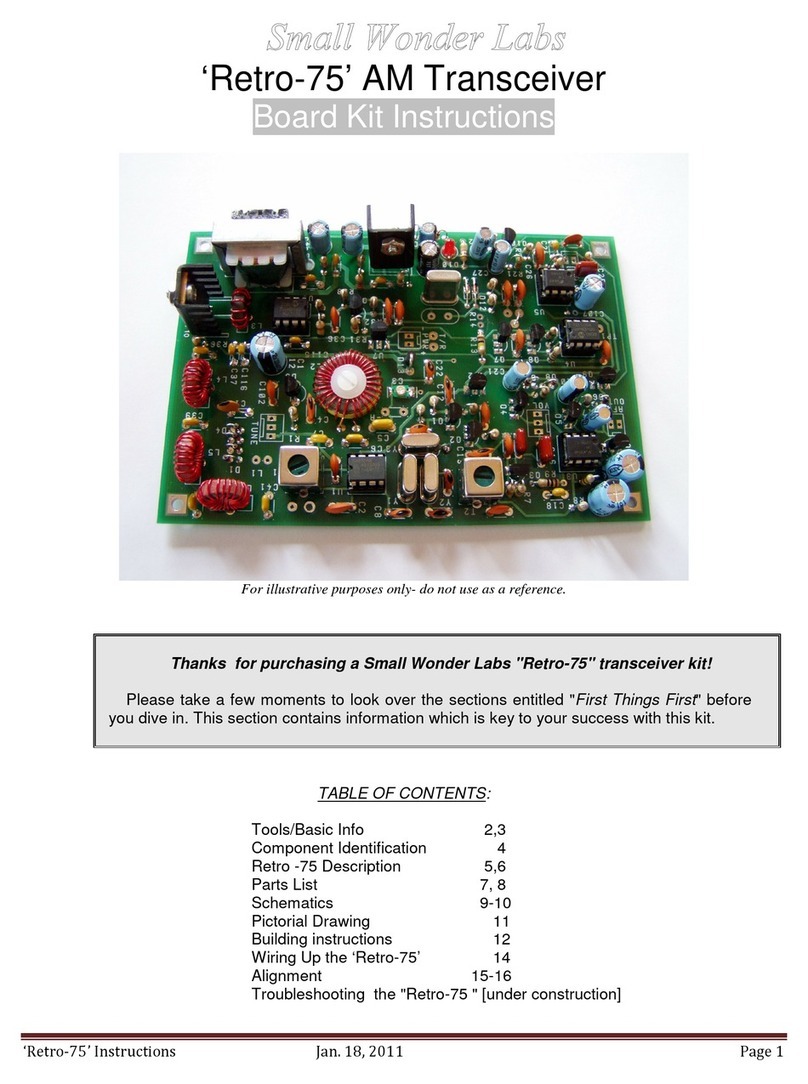
Small Wonder Labs
Small Wonder Labs Retro-75 User manual
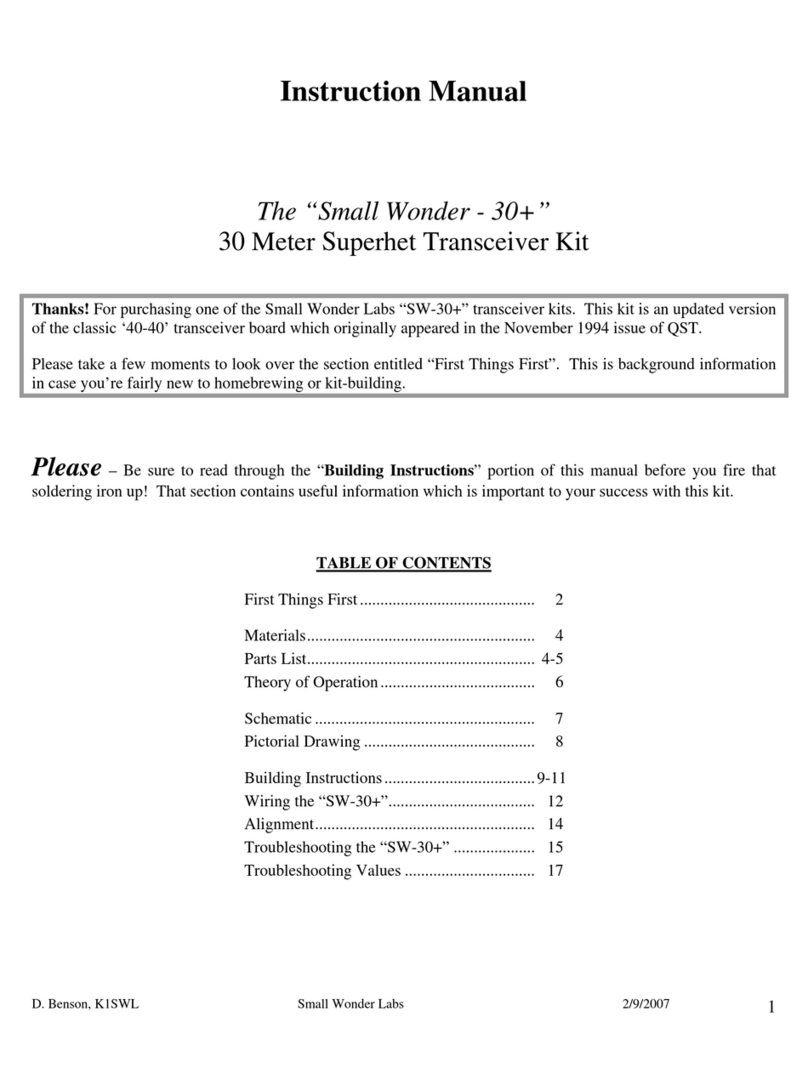
Small Wonder Labs
Small Wonder Labs SW-30+ User manual
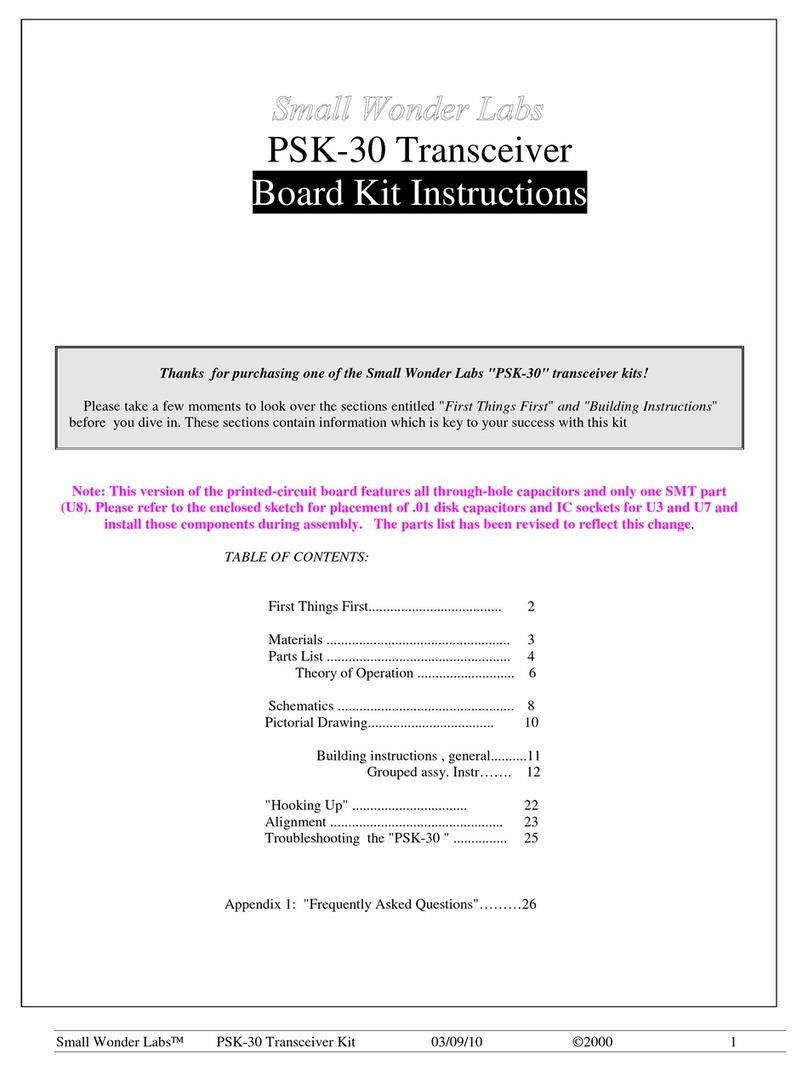
Small Wonder Labs
Small Wonder Labs PSK-30 Manual
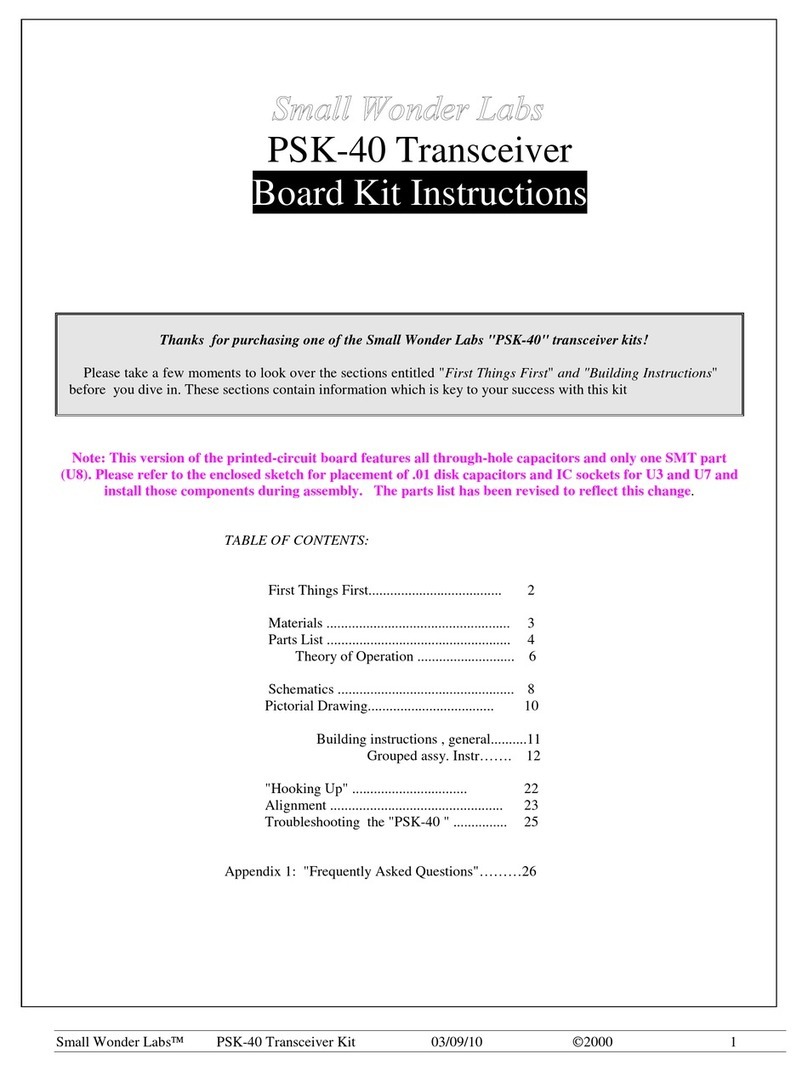
Small Wonder Labs
Small Wonder Labs PSK-40 User manual
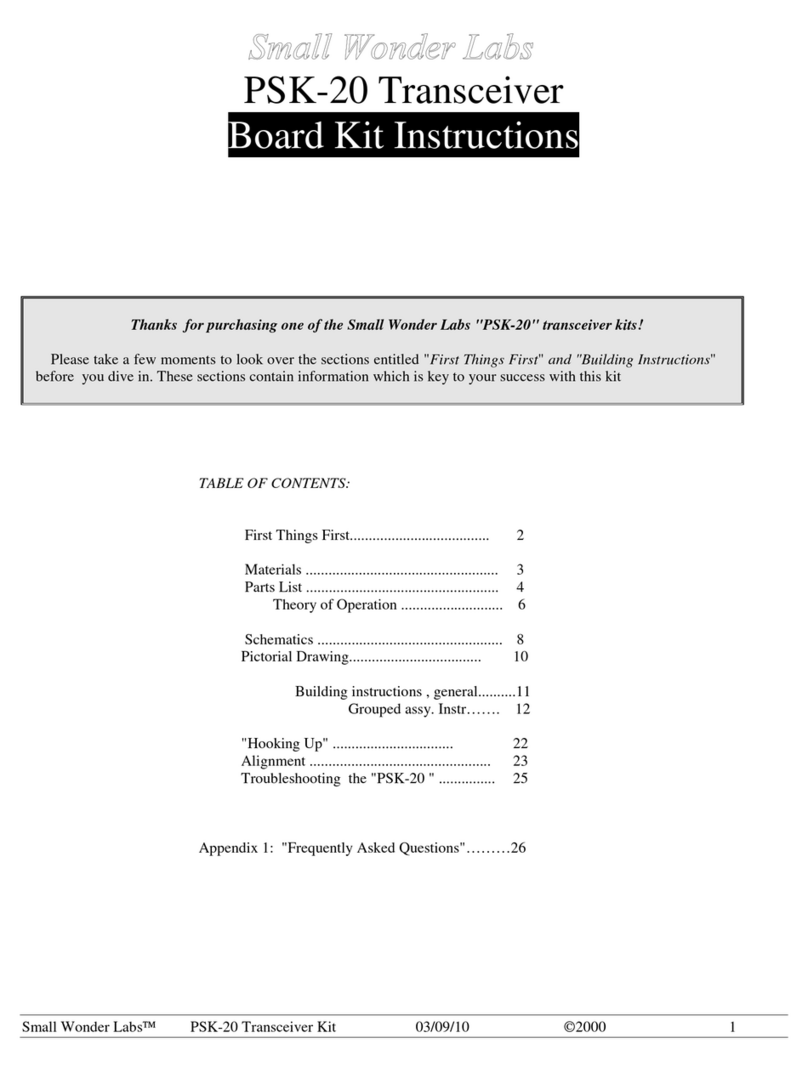
Small Wonder Labs
Small Wonder Labs PSK-20 User manual
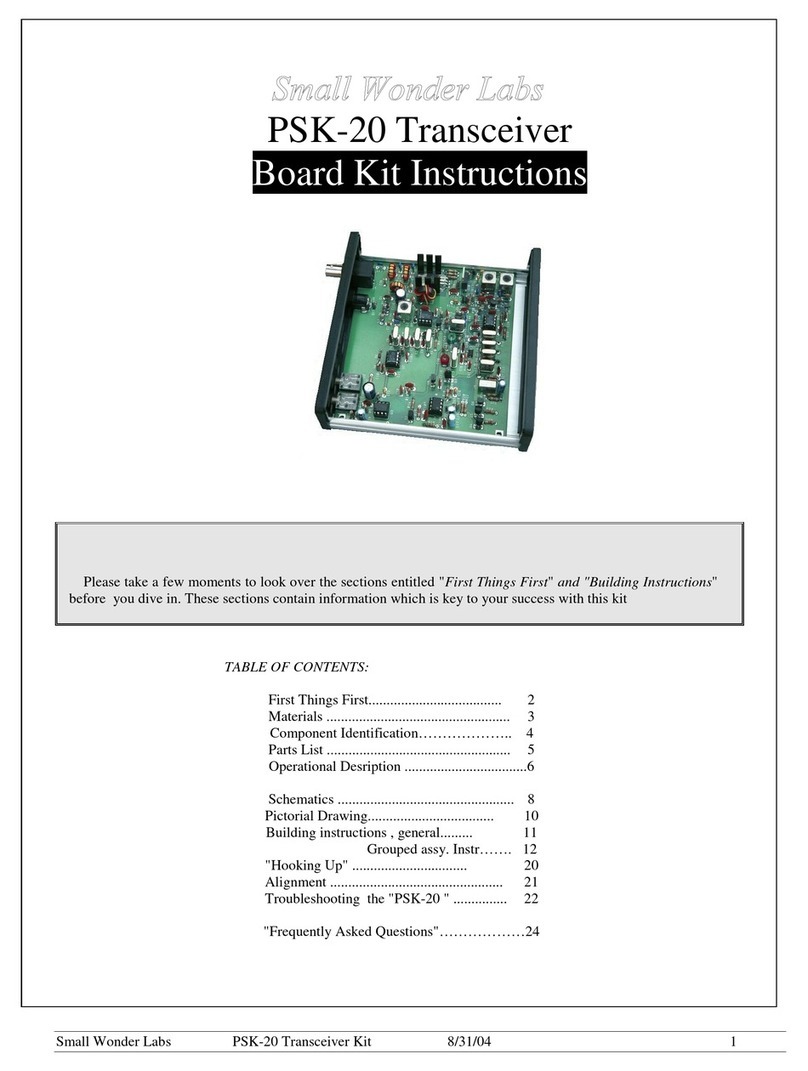
Small Wonder Labs
Small Wonder Labs PSK-20 User manual
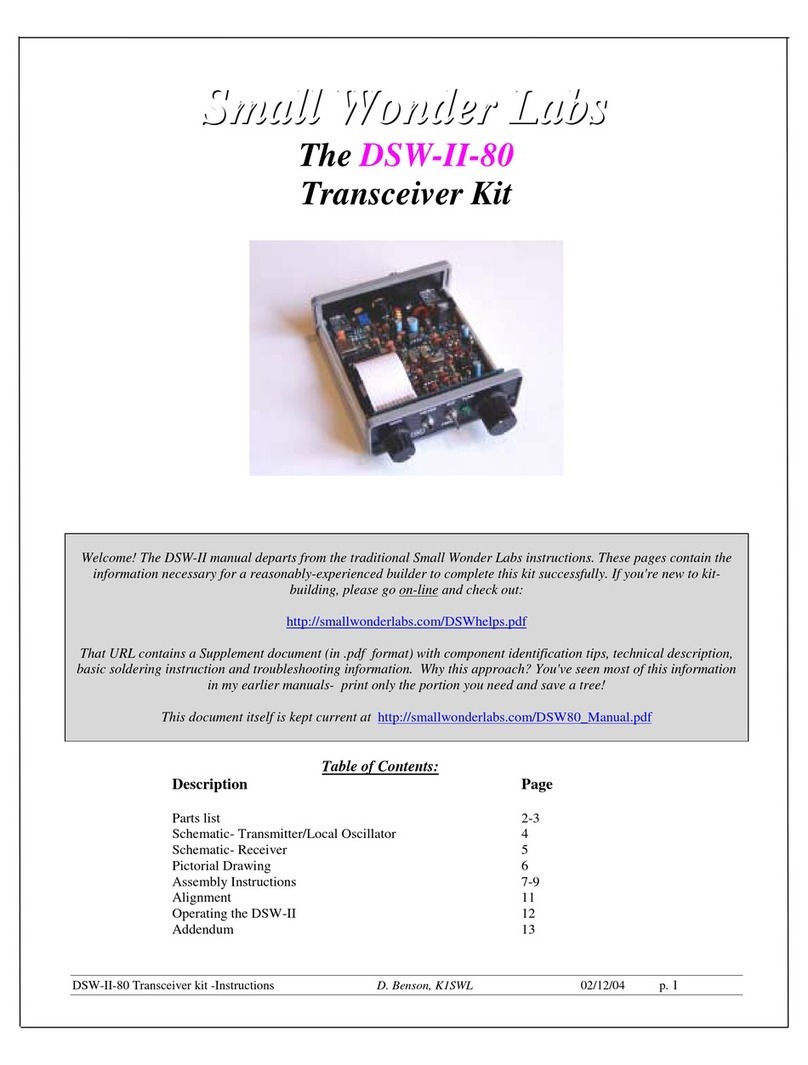
Small Wonder Labs
Small Wonder Labs DSW-II-80 User manual
